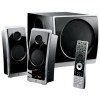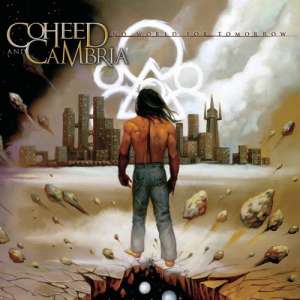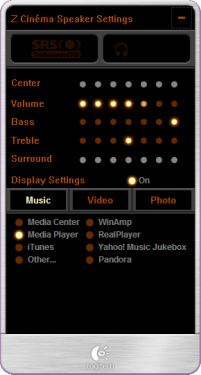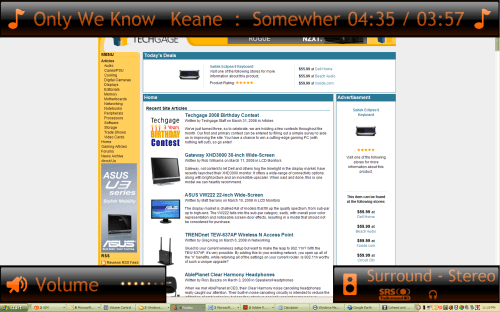- Qualcomm Launches Snapdragon 4 Gen 2 Mobile Platform
- AMD Launches Ryzen PRO 7000 Series Mobile & Desktop Platform
- Intel Launches Sleek Single-Slot Arc Pro A60 Workstation Graphics Card
- NVIDIA Announces Latest Ada Lovelace Additions: GeForce RTX 4060 Ti & RTX 4060
- Maxon Redshift With AMD Radeon GPU Rendering Support Now Available
Logitech Z Cinema Speaker System

Logitech unveiled their Z Cinéma speaker system at this year’s CES, to plenty of fanfare. The system blends a refined two-way satellite design with a robust, powerful subwoofer. We take the latest high performance Z-series PC speaker system for a spin, and find lots of cause for excitement.
Page 4 – Software; Testing
From the impressive hardware and technology we’ve seen so far, it’s clear that Logitech isn’t messing around with the Z Cinéma system. The Z Cinéma speakers integrate their own audio codec processing, which eliminates the need for a sound card altogether – preserving a pure digital path from the PC to the loudspeaker drivers themselves.
The Z Cinéma speaker system requires you to install a control program from the supplied CD-ROM in order to use the SRS TruSurround HD functionality, whose DSP processing is done in software. The control program allows software-based control of the system volume, channel levels, and tone controls, and provides on-screen display of the current system settings whenever a change is made.
This display can be fairly cumbersome and blocky at times, but thankfully it can be disabled altogether, with only the illuminated display on the right satellite speaker providing visual feedback. The on-screen display worked fine with Windows Media Player, but wouldn’t reflect changes made in foobar2000, which I use to play FLAC files.
Testing
To perform listening testing, I used my reference PC, which is outfitted with a high-quality ASUS Xonar sound card, as well as a silent cooling system. All source material used in critical listening testing was taken either directly from compact disc, or from lossless FLAC-encoded files.
Test material covered a variety of musical types and genres, as well as a DVD source for testing the effectiveness of the Z Cinéma’s virtual-surround processing. Music listening was performed with the SRS TruSurround HD virtual-surround processing disabled, and movie testing was performed with the TruSurround processing enabled. The speakers were set up three feet apart, with listening performed at a distance of three feet away, and the subwoofer was placed on the floor directly between the main speakers.
- Test System
- CPU: AMD Athlon 64 X2 5200+ 2.6GHz
- Motherboard: ABIT KN9 Ultra (NForce 570; MCP-55)
- Memory: 2 GB OCZ Gold DDR2-1100 @ DDR-800
- GPU: ATI Radeon HD 3870, 512MB
- Sound Card:ASUS Xonar D2
- PSU: Antec NeoHE 500W
- Silent microprocessor-controlled cooling system
- Reference Headphones: Beyerdynamic DT 770, “2005” Edition (250 Ohm)
Music
To kick off critical music listening, I picked Keane’s 2004 release, Hopes and Fears. This album is midrange-rich, yet also possesses a dynamic low-end and a variety of percussion textures throughout its length. My favorite track on this album is #3, “Bend and Break”, and on it, the Z Cinéma demonstrated its extremely smooth midrange and non-fatiguing treble performance. I also noticed some amount of midbass bleed-through into the subwoofer’s output, which is a disconcerting observation because it suggests a crossover frequency between the subwoofer and main speakers that slightly too high.

The satellites of the Z Cinéma system really showed their stuff with the next track, “We Might As Well Be Strangers”, perfectly centering the vocal between the speakers amidst the hard-panned instrumental and percussive effects. The final track of the album, “Bedshaped,” demonstrated these speakers’ ability to communicate emotion – in this case, deep melancholy – through their ability to render such subtle detail as the vocalist’s breath and the woodiness of a drumstick thwacking the rim of the snare drum. Yet in the chorus, the closed-in feel of the mix expands dramatically and reverberantly, and the Z Cinéma’s satellites adeptly communicate this as well.

Coheed and Cambria’s Good Apollo, I’m Burning Star IV, Volume Two: No World For Tomorrow provided a change of pace, with its impactful rock style that’s been described as vaguely Rush-esque. Perhaps the best example of the style similarity is track #3, “The Hound (Of Blood And Rank)”. I took this opportunity to crank the system to its maximum. Though the level at maximum volume nearly drove me out of the room, and kick drum hits pounded me mercilessly in the chest, the system’s output remained clean and clear, and the all-important kick hits continued to waffle my pant legs, even at a distance. One thing is clear from this – these babies crank, and hang together nicely even at uncomfortable levels that had me worried I’d be visited by the police on a noise complaint.
Movies
To test the Z Cinéma’s ability to simulate the subtleties of a rich surround sound field, I used Twentieth Century Fox’s Little Miss Sunshine. In the opening scene of the DVD, “Hoovers Plus One,” the bustle of a busy household was rendered with startling precision, even as activity seemed to take place all around me.

The surround sound field generated by the TruSurround HD processing didn’t completely envelop me. Instead, like a good set of dipole surround speakers placed to either side of my head, the sound field grew more diffuse behind my head. Indeed, without the need to place and wire rear surround speakers, I was experiencing real surround sound.
The subwoofer also got plenty of action as well, pounding out the energetic tracks in the final beauty-pageant scene without getting in the way of dialogue. I noticed that with stereo music, TruSurround created an unnatural effect of spaciousness, but with multichannel DVD soundtracks, the effect of TruSurround is highly believable.
|
|
Support our efforts! With ad revenue at an all-time low for written websites, we're relying more than ever on reader support to help us continue putting so much effort into this type of content. You can support us by becoming a Patron, or by using our Amazon shopping affiliate links listed through our articles. Thanks for your support!






